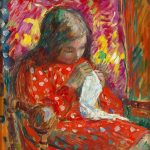Henri Matisse, a towering figure in 20th-century art, was born on December 31, 1869, in Le Cateau-Cambrésis, a small town in northern France. Renowned for his revolutionary contributions to modern art, Matisse’s influence spanned painting, sculpture, drawing, and the development of modern art movements.
Matisse’s artistic journey began when he studied law in Paris, but his passion for art led him to abandon his legal career for a life dedicated to painting. In 1891, he enrolled at the Académie Julian and later studied under the tutelage of the academic painter Gustave Moreau at the École des Beaux-Arts. This marked the beginning of Matisse’s formal art education.
The early phase of Matisse’s career was characterized by his association with the Fauvist movement, a group of artists known for their bold use of color and brushwork. The Fauvist period, particularly exemplified in works like “Woman with a Hat” (1905), showcased Matisse’s departure from traditional representational color usage.
Matisse’s art underwent a transformative period during the early 1910s when he, along with artists like Pablo Picasso, played a pivotal role in the development of Cubism. Matisse’s engagement with Cubist principles is evident in works such as “Portrait of Madame Matisse (The Green Stripe)” (1905) and “The Dance” (1910). However, Matisse maintained a distinctive style that incorporated a more decorative and expressive use of color and form.
The artist’s travels to North Africa significantly influenced his work, inspiring a fascination with exoticism and Orientalism. The bold colors, patterns, and flattened forms in paintings such as “The Moorish Screen” (1921) reflected these influences. Matisse’s adept use of color became a hallmark of his work, earning him a reputation as a master colorist.
The latter part of Matisse’s career saw him delving into a more relaxed and lyrical style. Health issues compelled him to explore new artistic avenues, leading to the creation of his renowned cut-out technique. This period, marked by works like “The Snail” (1953), demonstrated Matisse’s ability to innovate and create with simplicity and vitality.
Beyond his role as a painter, Matisse was a prolific sculptor, printmaker, and illustrator. His influence extended beyond the canvas into the realms of interior design and book illustration. His collaborations with artists, writers, and musicians showcased the interdisciplinary nature of his creative pursuits.
Henri Matisse’s artistic legacy is immeasurable, and his impact on the trajectory of modern art is profound. His work is celebrated for its vibrancy, expressiveness, and the enduring quest for artistic innovation. Matisse passed away on November 3, 1954, in Nice, France, leaving behind a body of work that continues to captivate and inspire art enthusiasts and creators around the world.





